| Listing 1 - 10 of 17 | << page >> |
Sort by
|
Book
ISBN: 9789004515000 9789004514232 9004514236 9004515003 Year: 2022 Publisher: Leiden ;Boston Brill
Abstract | Keywords | Export | Availability | Bookmark
 Loading...
Loading...Choose an application
- Reference Manager
- EndNote
- RefWorks (Direct export to RefWorks)
"Writing in the late 19th century, Mózes Salamon, rabbi of a small Hungarian community, hoped to convince his fellow rabbis to recognize women as equally privileged members of the People Israel. The result was his The Path of Moses: A Scholarly Essay on the Case of Women in Religious Faith, a ground-breaking enquiry into the causes of women's exclusion from most of Judaism's religious practices. Predating contemporary feminism, it gave early expression to ideas found in today's religious feminist critique of women's role in Judaism, thus undermining attempts to dismiss those ideas as shallowly mimicking fashionable secular opinion. The Path of Moses is here published for the first time in English, accompanied by the Hebrew original, an introduction, and commentary. This book is an updated and extended version of M. Salamon, Netiv Moshe: Maamar Mehkari 'al Ma'amad haNashim baEmunah , Vienna 1899, originally published in Hebrew"--
Women in Judaism --- Jewish women --- Feminism --- History --- Religious aspects --- Judaism
Book
ISBN: 9780199743186 0199743185 019989468X 0199781206 9786612900013 1282900013 0199916519 Year: 2011 Publisher: Oxford [etc.] Oxford University Press
Abstract | Keywords | Export | Availability | Bookmark
 Loading...
Loading...Choose an application
- Reference Manager
- EndNote
- RefWorks (Direct export to RefWorks)
Women and religion--Rome. --- Women in Judaism--Rome. --- Women in Christianity--Rome. --- Rome--Religion.
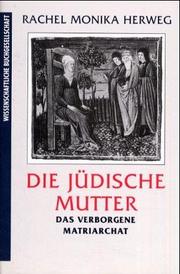
ISBN: 3534124936 Year: 1994 Publisher: Darmstadt Wissenschaftliche Buchgesellschaft
Abstract | Keywords | Export | Availability | Bookmark
 Loading...
Loading...Choose an application
- Reference Manager
- EndNote
- RefWorks (Direct export to RefWorks)
Jewish women. --- Feminism --- Mothers. --- Women in Judaism. --- Religious aspects --- Judaism. --- Women [Jewish ] --- Social conditions --- History
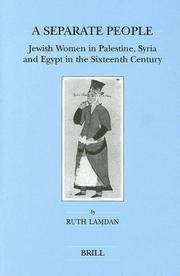
ISBN: 9004117474 9004500936 Year: 2000 Volume: 26 Publisher: Boston ; Leiden ; Köln Brill
Abstract | Keywords | Export | Availability | Bookmark
 Loading...
Loading...Choose an application
- Reference Manager
- EndNote
- RefWorks (Direct export to RefWorks)
Femmes dans le judaïsme --- Vrouwen in het jodendom --- Women in Judaism --- Women --- Legal status, laws, etc. (Jewish law) --- Jewish women --- Palestine --- Social conditions --- 16th century --- Syria --- Egypt

ISBN: 155540765X Year: 1992 Volume: vol 59 Publisher: Atlanta, Ga. Scholars Press
Abstract | Keywords | Export | Availability | Bookmark
 Loading...
Loading...Choose an application
- Reference Manager
- EndNote
- RefWorks (Direct export to RefWorks)
Femmes dans le judaïsme --- Vrouwen in het jodendom --- Women in Judaism --- 396.7 --- Jewish women --- -Jewish women --- -Women, Jewish --- Women --- Judaism --- Vrouw en religie --- History --- Religious life --- -Vrouw en religie --- 396.7 Vrouw en religie --- -396.7 Vrouw en religie --- Women, Jewish --- Women [Jewish ] --- Women in Judaism. --- Women, Jewish - History. --- Women, Jewish - Religious life.
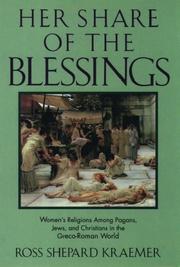
ISBN: 0195086708 0195066863 9780195066869 9780195086706 Year: 1994 Publisher: New York Oxford University Press
Abstract | Keywords | Export | Availability | Bookmark
 Loading...
Loading...Choose an application
- Reference Manager
- EndNote
- RefWorks (Direct export to RefWorks)
Ross Shepard Kraemer vividly recreates the religious lives of early Christian, Jewish, and pagan women, with many fascinating examples (...). The relationship among female autonomy, sexuality, and religion emerges as a persistent theme. Analyzing the monastic Jewish Therapeutae and various Christian communities, Kraemer demonstrates the paradoxical liberation which women achieved by rejection of sexuality, the body, and the female. In the epilogue, Kraemer pursues the disturbing implications such findings have for contemporary women. [publisher's description]
Women in Judaism --- Femmes dans le christianisme --- Femmes dans le judaïsme --- Geschichte (30-500) --- Mittelmeerraum --- Mediterranean region. --- Paganism --- Women and religion --- Women in Christianity --- Women --- History. --- History --- Religious life --- Mittelmeerraum. --- Mediterranean region --- Primitive and early church, ca. 30-600 A.D. --- Women - Mediterranean Region - Religious life - History. --- Women and religion - History. --- Women in Judaism - History. --- Women in Christianity - History - Early church, ca. 30-600.
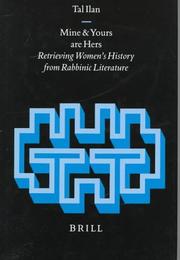
ISBN: 9004108602 9004332456 9789004108608 9789004332454 Year: 1997 Volume: 41 Publisher: Leiden ;New York Brill
Abstract | Keywords | Export | Availability | Bookmark
 Loading...
Loading...Choose an application
- Reference Manager
- EndNote
- RefWorks (Direct export to RefWorks)
This book discusses the interaction between history, rabbinic literature and feminist studies. Recent approaches to rabbinic literature have overturned the traditional view of these writings and new literary methods were suggested, mostly denying them all historical value. But rabbinic literature constitutes the main source for the lives of Jews in Palestine and Babylonia during the late Roman period, and thus should not be totally rejected. This study suggests a new post-literary approach, id est it discusses the residue of the texts after these have been analyzed and dissected by literary critics. But mainly this is a book about women's history, adopting many assumptions of feminist criticism about the androcentric nature of all ancient texts, and approaches them with due suspicion. The Rabbis treated women differently from the way they treated men. This resulted in the former's marginalization and manipulation by the texts. On the other hand, however, it created an ironic situation whereby principles useful for the recovery of historical information on women, are useless when applied to men. This study describes such principles and demonstrates them with the help of many examples.
Women in rabbinical literature --- Women in Judaism --- Rabbinical literature --- Historiography --- History and criticism --- 296*23 --- -Women in rabbinical literature --- -Judaism --- Women in the Talmud --- Hebrew literature --- Jewish literature --- Talmudcommentaren --- -Talmudcommentaren --- 296*23 Talmudcommentaren --- -Women in the Talmud --- Judaism --- Talmud --- Talmud Bavli --- Babylonian Talmud --- Talmud, Babylonian --- Talmud Vavilonskiĭ --- Talmoed, Babylonische --- Babylonische Talmoed --- Shas --- Shishah sedarim --- Talmud of Babylonia --- Talmud de Babilonia --- Talmud Babli --- Talmouth --- Talmod --- Criticism, interpretation, etc. --- Sources. --- Women in rabbinical literature. --- Women in Judaism - Historiography. --- Rabbinical literature. --- Historiography. --- History and criticism. --- Talmud. --- Talmud Vavilonski --- Women in Judaism - Historiography --- Rabbinical literature - History and criticism
Book
ISBN: 9782503545370 2503545378 Year: 2012 Volume: 157 Publisher: Turnhout: Brepols,
Abstract | Keywords | Export | Availability | Bookmark
 Loading...
Loading...Choose an application
- Reference Manager
- EndNote
- RefWorks (Direct export to RefWorks)
En hébreu rabbinique, le terme niddah désigne la femme au moment de ses règles, le sang menstruel en soi, ou la période d’impureté liée à la menstruation. Une réglementation stricte concerne la femme niddah dans la loi religieuse juive (halakhah) ; notamment, les relations conjugales sont interdites pendant cette période. Parmi les nombreux textes qui traitent des questions liées à la menstruation, la Baraïta de-Niddah est de loin le plus étrange. Écrit en hébreu, il est difficile à dater et à localiser : peut-être peut-on le situer en Palestine, dans la seconde moitié du premier millénaire de l’ère chrétienne. Précédemment, il n’a été publié qu’une fois, en 1890. La présente édition, accompagnée d’une traduction française, voudrait permettre un accès à ce texte fascinant aux hébraïsants ainsi qu’aux non-spécialistes. Prétendant à un statut de texte législatif classique, cette pseudo-Baraïta (texte contemporain de la Mishna, mais qui n’a pas été reçu dans le recueil officiel) a eu un statut ambigu dans la tradition rabbinique. Sans aucun souci de chronologie par rapport aux personnages dont elle cite les propos, elle est en fait un recueil de croyances populaires, où se mêlent des considérations qui se veulent médicales, des observations naturelles étonnantes et, surtout, une peur extrême de la femme menstruée. Ce texte constitue un document particulièrement remarquable, qui devrait susciter l’intérêt aussi bien des ethnologues et des sociologues que des spécialistes de l’histoire des rapports hommes/femmes et des religions.
Jewish women --- Menstruation --- Women in Judaism --- Juives --- Femmes dans le judaïsme --- Religious life --- Religious aspects --- Judaism --- Vie religieuse --- Aspect religieux --- Judaisme --- 296*213 --- Baraita --- 296*213 Baraita --- Femmes dans le judaïsme --- Purity [Ritual ]
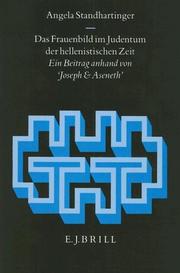
ISBN: 9004103503 9004332790 9789004103504 9789004332799 Year: 1995 Volume: 26 Publisher: Leiden ;New York E.J. Brill
Abstract | Keywords | Export | Availability | Bookmark
 Loading...
Loading...Choose an application
- Reference Manager
- EndNote
- RefWorks (Direct export to RefWorks)
Each of the two reconstructed “oldest texts” of the intertestamental work, Joseph and Aseneth , presents a consistent picture with a coherent theology, but there are considerable differences between them. The image of women in each case serves to crystallise these differences, and their analysis opens a window not only on the texts but also on their social contexts. The author develops a method which allows close study of ancient literary images of women and of their effects on ancient readers. It is shown that the different images portrayed in the two versions correspond to differing trends in the pagan and Jewish environment and in Jewish-Hellenistic interpretations of the Bible. A controversy of social and theological importance emerges.
Femmes dans le judaïsme --- Vrouwen in het jodendom --- Women in Judaism --- Women in Judaism. --- Joseph and Aseneth --- Criticism, interpretation, etc. --- 229*227 --- Judaism --- Jozef en Asenath --- Theses --- 229*227 Jozef en Asenath --- Femmes dans le judaïsme --- Aseneth (Biblical tale) --- Bible. --- Book of Aseneth --- Confession and prayer of Aseneth --- Conversion of Aseneth --- Joseph and Asenath --- Joseph u. Aseneth --- Joseph und Aseneth --- Prayer of Aseneth --- Criticism, interpretation, etc --- Joseph and Aseneth.
Periodical
ISSN: 15655288 Year: 1998 Publisher: Jerusalem : Waltham, MA : Jerusalem : Waltham, MA : Bloomington, IN : Schechter Institute of Jewish Studies : International Research Institute on Jewish Women, Brandeis University, Schechter Institute of Jewish Studies : Hadassah International Research Institute on Jewish Women, Brandeis University Indiana University Press
Abstract | Keywords | Export | Availability | Bookmark
 Loading...
Loading...Choose an application
- Reference Manager
- EndNote
- RefWorks (Direct export to RefWorks)
Nashim provides an international, interdisciplinary, and scholarly forum in Jewish women’s and gender studies, and is the only one of its kind. It creates communication channels within the Jewish women’s and gender studies community and brings forth that community’s work to a wider audience. Each thematic issue is produced in consultation with a distinguished feminist scholar, and includes articles on literature, text studies, anthropology, archeology, theology, contemporary thought, sociology, the arts, and more. Nashim is a joint publication of the Hadassah-Brandeis Institute at Brandeis University, the Schechter Institute of Jewish Studies in Jerusalem, and Indiana University Press.
Jewish women --- Women in Judaism --- Feminism --- Jewish women. --- Women in Judaism. --- Religious aspects --- Judaism --- Judaism. --- Israel. --- Women, Jewish --- Women --- Jewish feminism --- Emancipation of women --- Feminist movement --- Women's lib --- Women's liberation --- Women's liberation movement --- Women's movement --- Social movements --- Anti-feminism --- Emancipation --- Dawlat Isrāʼīl --- Država Izrael --- Dzi︠a︡rz︠h︡ava Izrailʹ --- Gosudarstvo Izrailʹ --- I-se-lieh --- Israele --- Isrāʼīl --- Isŭrael --- Isuraeru --- Izrael --- Izrailʹ --- Medinat Israel --- Medinat Yiśraʼel --- Stát Izrael --- State of Israel --- Yiselie --- Yiśraʼel --- Middle East --- Dzi͡arz͡hava Izrailʹ --- Juives --- Femmes dans le judaïsme --- Israel --- Femmes dans le judaïsme
| Listing 1 - 10 of 17 | << page >> |
Sort by
|

 Search
Search Feedback
Feedback About UniCat
About UniCat  Help
Help News
News